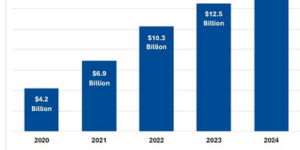This year’s January reinsurance renewals were described by brokers as “stable,” “predictable,” “orderly,” “calmer,” “disciplined,” with “increased appetites” and a return to supply/demand balance. What a difference in tone from last year’s grueling January renewals.
“In a marked change on a year ago, the supply of property-catastrophe reinsurance capacity at the January 1 renewal was more than adequate to meet demand, resulting in a competitive environment for peak perils and upper layers,” according to Aon in a market report titled “Reinsurance Market Dynamics – January 2024.”
Indeed, Aon said, most reinsurers entered the renewals “with ambitions to grow in property-catastrophe reinsurance and the market was therefore more consistent in its approach to pricing and terms.”
“This year, property supply and demand has snapped back into balance, with returns for the first three quarters of 2023 exceeding reinsurers’ increased cost of capital,” according to Gallagher Re’s 1st View report, titled “What a Difference a Year Makes.”
“Retained earnings, modest new capital raises, ample retrocessional capacity and buoyant ILS markets combined to increase available catastrophe reinsurance limit,” the report said.
Related: Reinsurance Buyers Find ‘Smoother’ January Renewals With Ample Capacity: Carpenter
Gallagher Re said the structural changes seen during the January 2023 renewals “really were an exception, with a much calmer renewal period and an improved alignment of all parties’ expectations leading into 2024.”
The January 2024 renewal season “provided a welcome return to more stability and predictability, allowing the expectations of all parties to be managed in a less rancorous fashion than 12 months ago,” Gallagher Re affirmed.
“The January 1, 2024 treaty renewal proceeded relatively smoothly, as a rebound in profitability, rebuilding capital positions and greater availability of retrocession capacity encouraged many reinsurers to display increased appetites at the enhanced terms established in 2023,” said Aon’s report.
“Renewals took place in an environment of more favorable supply dynamics, but also underwriting discipline,” according to Howden in a release that accompanied its market report, titled “A new world.” “The result was a relatively stable and orderly renewal, with supply more than sufficient to meet increased demand.”
“Pricing was stable overall, with any significant variation by territory or line of business informed by loss experience. Structures saw incremental changes, having undergone significant adjustments in 2023,” the Howden report said.
“Dedicated reinsurance capital has recovered to near record levels. Generationally strong pricing, favorable terms and conditions in key lines of business and pursuant, higher returns on capital have enticed capacity back into the market through multiple channels,” commented David Flandro, head of Industry Analysis and Strategic Advisory, Howden Tiger, in a statement.
“This, combined with a rapid recovery in traditional balance sheets has meant there was excess capacity for some placements. The structure of the reinsurance market continues to change, with alternative capital now comprising nearly a quarter of the total,” Flandro added.
“Retentions remained stable as healthy levels of capacity put pressure on pricing, and over-placements led to strong signings. Capacity for frequency protection was once again at a premium. This led to stronger competition further up programs, with some higher-attaching layers oversubscribed and competitively priced,” Howden’s report continued.
“Towards the end of the renewal season, discussions focused on reinsurer signing activity as supply increase outstripped demand year on year. Expected returns remain a key hurdle for reinsurers as underwriting remained front and center for renewals, but capacity was available where return thresholds were met,” Aon’s report said.
Gallagher Re also pointed to signs of over-placements on well-structured programs, which indicates that some buyers will see improving positions going into 2024. “From a pricing and structure perspective, reinsurers managed to hold their positions, but perhaps not always their shares, and some buyers remain dissatisfied about the lack of available capacity for earnings protections.”
Cedent Challenges
“For many cedents, it was a challenging year. Capital buffers had already been eroded by unrealized investment losses going into 2023 and many were carrying less reinsurance coverage principally in the form of higher retentions forced by reinsurers in 2023,” said Aon, noting that insured losses from natural catastrophes were again at elevated levels relative to historic averages.
“Insured catastrophe losses exceeded $100 billion for the fourth straight year in 2023, indicating an elevated baseline for loss expectations. The lion’s share of insured losses were borne by insurers following reinsurers’ structural retreat from frequency risks through 2023’s renewal cycle,” according to Howden’s report.
These global catastrophe claims were “driven mainly by an unprecedented impact from severe convective storm activity in the U.S. and Italy, windstorm Ciaran in France, flood losses in New Zealand, flood and wildfire losses in Greece, a major earthquake in Turkey and Hurricane Otis in Mexico,” Aon said.
Ceding companies also had to bear most of the losses from severe convective storms (SCS), which exceeded $59 billion in 2023.
Such losses not only eroded capital, but they also introduced more volatility into underwriting results “and resulted in increased rating agency scrutiny for many insurers which has driven some increased demand for reinsurance protection going into 2024,” Aon continued.
Ceding companies also had to bear most of the losses from severe convective storms (SCS), which exceeded $59 billion in 2023. U.S. insurers assumed most of the SCS losses net, “given increased retentions and the scarcity of aggregate protection,” said Gallagher. “Divergence also exists in personal and commercial lines, with those operating in tightly regulated markets having limited ability to pass on the increased cost of risk.”
Better Communication
Howden’s report noted that reinsurers’ plans were better telegraphed in the weeks leading up to Jan. 1, 2024, which meant that “the tensions and dislocations that characterized last year’s renewal were far less acute.”
Aon agreed by saying that this year’s property renewals “proceeded in a timely manner, with most reinsurers taking a more constructive and open approach.”
“Following a challenging 2023, global insurers have renewed their focus on trading relationships, reinforcing the value placed on consistent reinsurer communication and the breadth of trading relationships,” Aon said.
Indeed, Aon emphasized that differentiation in the behavior of both insurers and reinsurers was important during the January 2024 renewals.
“Insurers that did not have loss experience in 2023 and/or those that were able to articulate positive changes to underwriting portfolios achieved the best possible outcome. At the same time, reinsurers that were timely and constructive in quoting, authorized broadly on a program, and were regarded as valued partners over the past 12 months were rewarded by insurers at 1/1,” Aon continued.
Generally, insurers looked to reward reinsurers that were most supportive during the challenging 2023 renewals, Aon noted.
This article was previously published on Insurance Journal. Reporter L.S. Howard is the International and Reinsurance Editor for Insurance Journal and Carrier Management.
Related:





















 Federal Bill Reintroduced to Combat Organized Retail Theft
Federal Bill Reintroduced to Combat Organized Retail Theft  U.S. P/C Industry Combined Ratio Headed Back Up to 100: S&P Ratings
U.S. P/C Industry Combined Ratio Headed Back Up to 100: S&P Ratings  Don’t Forget Workers Comp Tariff Impacts: Berkley
Don’t Forget Workers Comp Tariff Impacts: Berkley  The Growth of a New Wave of Distribution Startups in Commercial Auto Insurance
The Growth of a New Wave of Distribution Startups in Commercial Auto Insurance 







